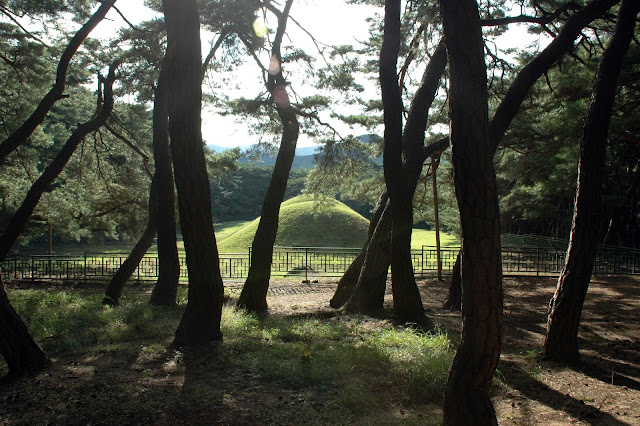Whole Area of Namsan , Gyeongju
Mt. Namsan compries Mt. Geumo (486m high) , located to the south of Serabeol, the ancient capital of the Silla Kingdom, and Mt. Gowi ( 494 m high ) , It streches 4km from the south to the north, and 8km in width from the east to the west, including over 40 mountain valleys, Thus , Namsab is often referred to as " an open air museum".and is the place where the breath of the Silla Kingdom is felt.
This mountain has numerous historic relics along with pre-historilcal relics: the Najeong Well, Jegendary brithplace of Bak Hyeokgeose ( 1st king of Silla ) : Namsan foress: King's tombs: and Poseokjeong . In addition, the mountain has countless Buddist remains. A resent research reveals that it has 122 temple sites. 57 stone Buddhas, 64 stone pagoas, and 19 stone lamps. these Buddhist relics born out of a marriage between Buddhist faith and the natural environment epitomize Bulgukto, the ideal Buddhist land of the Silla people
Location ; Bae -dong Gyeongju-si Gyeongsangbuk-do Korea
Three Royal Tombs in Bae-ri
There are the tombs of three Silla Kings : King Adalla (154~184), the 8th King of the Silla Kingdom: King Sindeok (912~917, Bak Gyeong-hui) , the 53rd King of the Silla Kingdaom; and King Gyeongmyeong(917~924, Bak seung-yeong) the 54th King of the Silla kingdom.
when bakje Attacked Silla and captured Silla people, King Adalla himself went to the battle and set Bakje prisoners of war free at the request of peace. The mound of his tomb is 58m in circumference, 18m in diameter, and 5.4m in height.
king Sindeok became a king when his father-in -law, King Hyogong, died without an heir. After he became a king, he constantly fought against the attacks from Gyeonhwon and Gungye. The mound of his tomb is 61m in circumference ,18m in diameter, and 5.8m in height, In 1953 and 1963, the tomb was excavated.
King Gyeongmyeong was the son of King Sindeok. He defended the attacked of Gyeonghwon from Later Bakje at Daeyaseong fortress. His attempt at establishing diplomatic ties with Later Tang in China ended in failure. The mound is 50m in circumference , 16m in diameter, anf 4.5m in height.
Mt. Namsan compries Mt. Geumo (486m high) , located to the south of Serabeol, the ancient capital of the Silla Kingdom, and Mt. Gowi ( 494 m high ) , It streches 4km from the south to the north, and 8km in width from the east to the west, including over 40 mountain valleys, Thus , Namsab is often referred to as " an open air museum".and is the place where the breath of the Silla Kingdom is felt.
This mountain has numerous historic relics along with pre-historilcal relics: the Najeong Well, Jegendary brithplace of Bak Hyeokgeose ( 1st king of Silla ) : Namsan foress: King's tombs: and Poseokjeong . In addition, the mountain has countless Buddist remains. A resent research reveals that it has 122 temple sites. 57 stone Buddhas, 64 stone pagoas, and 19 stone lamps. these Buddhist relics born out of a marriage between Buddhist faith and the natural environment epitomize Bulgukto, the ideal Buddhist land of the Silla people
Location ; Bae -dong Gyeongju-si Gyeongsangbuk-do Korea
Three Royal Tombs in Bae-ri
There are the tombs of three Silla Kings : King Adalla (154~184), the 8th King of the Silla Kingdom: King Sindeok (912~917, Bak Gyeong-hui) , the 53rd King of the Silla Kingdaom; and King Gyeongmyeong(917~924, Bak seung-yeong) the 54th King of the Silla kingdom.
when bakje Attacked Silla and captured Silla people, King Adalla himself went to the battle and set Bakje prisoners of war free at the request of peace. The mound of his tomb is 58m in circumference, 18m in diameter, and 5.4m in height.
king Sindeok became a king when his father-in -law, King Hyogong, died without an heir. After he became a king, he constantly fought against the attacks from Gyeonhwon and Gungye. The mound of his tomb is 61m in circumference ,18m in diameter, and 5.8m in height, In 1953 and 1963, the tomb was excavated.
King Gyeongmyeong was the son of King Sindeok. He defended the attacked of Gyeonghwon from Later Bakje at Daeyaseong fortress. His attempt at establishing diplomatic ties with Later Tang in China ended in failure. The mound is 50m in circumference , 16m in diameter, anf 4.5m in height.





No comments:
Post a Comment